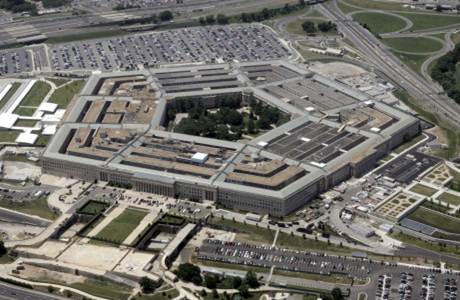Investing in Sustainability to Ensure Energy Independence and Political Stability

by Arnab Mukherjee, MBA ‘15

SGE immersion students learn that in light of climate change, the DOD is at the forefront of managing their carbon footprint, conducting research on alternative fuels and energy, and integrating green practices into their day-to-day operations.
Another year and students in the Sustainable Global Enterprise (SGE) immersion visited companies in the Washington, DC area from March 19 to March 21, in order to learn about the companies’ sustainability initiatives, including social impact and environmental initiatives. This year, a very diverse group of companies was on the list, including Calvert Investments, National Geographic, KaBOOM!, Grameen Foundation, Opower, USAID, and, what I was most excited about, the Department of Defense (DOD).

For the second year in a row, SGE immersion students were hosted by Tarak Shah, MBA ’08, at the DOD headquarters at the Pentagon. Vice Admiral Dennis V. McGinn (United States Navy, ret.), who serves as the Assistant Secretary of the Navy (Energy, Installations and Environment), and former President and CEO of the American Council on Renewable Energy (ACORE), gave us an overview of the DOD’s environmental sustainability initiatives. I was pleasantly surprised to learn that in light of climate change, the DOD is at the forefront of managing their carbon footprint, conducting research on alternative fuels and energy, and integrating green practices into their day-to-day operations. What I found most interesting is that given the increasing scarcity of resources and rapid global environmental degradation, the DOD is motivated by energy independence for the US armed forces and the economy as a whole because it sees the impact of climate change as an escalating threat to geopolitical and economic stability, rather than merely reducing their costs, emissions, and overall carbon footprint.
As part of its sustainability initiatives, the military has several LEED-certified buildings, including the Pentagon. Existing buildings and military bases are being retrofitted and renovated to improve energy efficiency and incorporate renewable energy sources such as solar and wind power. New buildings are constructed incorporating cutting-edge energy conservation and energy efficiency technologies. This is a measurement-driven approach where the military is using electric meters to more accurately determine demand and use, in turn better estimating and reducing energy costs. The DOD is also one of the largest purchasers of renewables like solar, wind and geothermal energy as well as more nascent technologies such as wave energy. The DOD recently sold one of the nation’s largest geothermal plants located in the Mojave Desert to Southern California Edison. This is a move for the DOD to off-load, instead of develop renewable energy, by establishing long-term power purchase agreements (PPAs) to utilize energy from these sources in operations for bases and offices.
The DOD is also investing in a variety of measures to address energy security and rapid response to natural disasters. Hospitals and medical centers have used backup generators for risk mitigation in times of power outages and natural disasters for decades. The DOD is working off this model to build “micro-grids”, i.e. self-sustained small-scale grids receiving their own supply from regular utilities, but supplemented by their own natural gas-powered fuel cells, geothermal resources, or other renewables. These micro-grids would measure what is being generated from which source and compare it to the demand and how this energy is utilized in order to determine where demand can be affected without decreasing the quality of life and preserving critical functions. The DOD is also partnering with utilities and technology companies on “smart grids” that enable computer-based remote control and automation in electricity systems, in turn improving energy efficiency, reducing distribution losses, and potentially improving response to natural disasters.
Finally, on the operational side, energy conservation and cost reduction is the primary goal. The DOD is also exploring new energy sources, traditional and renewable, in order to diversify its feedstock of energy. Traditional resources primarily include fossil fuels; to this end, the military is increasingly sourcing energy from natural gas, shale gas/propane (using new technologies such as horizontal drilling and fracking). While fracking is an environmentally invasive technology, the DOD suggests that oil drilling is increasingly competitive and much riskier, and as the competition for resources increases globally, so does the risk of conflict, thereby necessitating the use of less-than-ideal technologies like fracking.
The DOD is also exploring the use of biofuels, and other complex hydrocarbons. The biggest challenge is developing drop-in or infrastructure-compatible biofuels. To this end, the United States Navy has launched a “Great Green Fleet” of aircraft carriers and submarines which utilize advanced biofuel blends, i.e. 50-50 mixtures of biofuel (made from used cooking oil and algae) and petroleum-based marine diesel or aviation fuel. As stated on the Great Green Fleet website, it also utilizes energy efficient technologies such as solid state lighting (LEDs), gas turbine on-line water wash (allows compressors to be washing while engine is running to reduce costs, improve starter life, reduce maintenance costs), shipboard energy dashboard (real-time measurement and monitoring of energy utilization and demand associated with equipment), smart voyage planning decision aid (communication system between ships for optimal route plans), and stern flaps (reduce drag and turbulence, in turn lower fuel consumption).
I am happy to see the level of commitment from the DOD in matters of sustainability and environmental responsibility, but I personally question some of their technologies such as fracking. I also wonder if in the long run, the DOD will reduce the scale of its overall operations and spending as an alternative means to reduce their carbon footprint.
